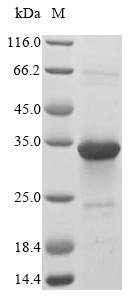Recombinant Rat Oncostatin-M (Osm) gets expressed in E. coli and includes the complete mature protein sequence, covering amino acids 26 to 208. The product comes with an N-terminal 10xHis-tag, which makes purification and detection more straightforward. SDS-PAGE analysis confirms the purity reaches above 85%, suggesting it should work reliably in research settings. Keep in mind this recombinant protein is strictly for research purposes—it's not appropriate for clinical or diagnostic use.
Oncostatin-M (Osm) belongs to the interleukin-6 cytokine family. This protein appears to play a significant role in controlling inflammation and how cells differentiate. Researchers often examine Osm because of its involvement in cell signaling pathways, especially those that influence immune responses and hematopoiesis. Its regulatory functions have made it a key target in studies looking at cellular growth and development.
Potential Applications
Note: The applications listed below are based on what we know about this protein's biological functions, published research, and experience from experts in the field. However, we haven't fully tested all of these applications ourselves yet. We'd recommend running some preliminary tests first to make sure they work for your specific research goals.
Rat OSM is a cytokine that requires proper disulfide bond formation, specific folding, and dimerization for its biological activity through receptor binding. The E. coli expression system cannot perform the necessary post-translational modifications (particularly correct disulfide bonding) that are critical for OSM's native conformation and function. While the protein may be soluble, it is highly unlikely to achieve the correct folding needed for functional receptor binding and signaling activity. The probability of correct folding with biological activity is low.
1. Antibody Development and Validation Studies
This recombinant OSM serves as an excellent immunogen for generating antibodies against linear epitopes of rat OSM. The full-length mature sequence ensures comprehensive epitope coverage. The His-tag facilitates purification and immunization procedures. However, antibodies may not efficiently recognize conformational epitopes on the native, properly folded OSM found in biological systems.
2. ELISA Development and Optimization
This protein is well-suited as a standard for quantitative ELISA to detect immunoreactive OSM levels. The assay depends on antibody binding to linear epitopes, so the protein's folding state is less critical. The His-tag enables consistent immobilization for reliable standard curve generation.
3. Biochemical Characterization and Stability Studies
This is the essential first step to assess the protein's physical properties. Techniques like size-exclusion chromatography can determine oligomeric state, while circular dichroism can analyze secondary structure content and thermal stability. These studies provide critical quality control data but characterize a misfolded protein, not native OSM.
Final Recommendation & Action Plan
The E. coli expression system is fundamentally unsuitable for producing a functional version of this complex cytokine, limiting its applications to non-functional uses. The protein can be reliably used for Application 1 (Antibody Development) and Application 2 (as an ELISA standard). Application 3 (Biochemical Characterization) should be prioritized to understand the protein's physical properties. Cytokine-receptor interactions must be avoided entirely as it requires native protein structure and function. For functional OSM studies, the only valid approach is to use the protein expressed in a eukaryotic system (e.g., mammalian cells) that can provide proper disulfide bond formation and folding.






